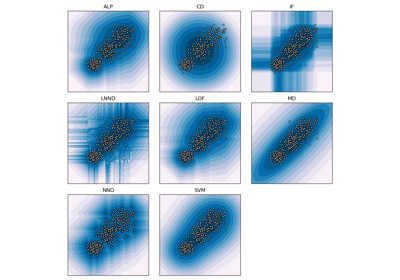NND#
- class frlearn.data_descriptors.NND(dissimilarity: str or float or Callable[[np.array], float] or Callable[[np.array, np.array], float] = 'boscovich', k: int or Callable[[int], float] or None = 1, weights: Callable[[int], np.array] | None = None, proximity: Callable[[float], float] = <function shifted_reciprocal>, nn_search: NeighbourSearchMethod = <frlearn.neighbours.neighbour_search_methods.KDTree object>, preprocessors=(<frlearn.statistics.feature_preprocessors.IQRNormaliser object>,))#
Implementation of the Nearest Neighbour Distance (NND) data descriptor, which goes back to at least [1]. It has also been used to calculate upper and lower approximations of fuzzy rough sets, where the addition of aggregation with OWA operators is due to [2].
- Parameters:
- dissimilarity: str or float or (np.array -> float) or ((np.array, np.array) -> float) = ‘boscovich’
The dissimilarity measure to use.
A vector size measure
np.array -> floatinduces a dissimilarity measure through application toy - x. A float is interpreted as Minkowski size with the corresponding value forp. For convenience, a number of popular measures can be referred to by name.The default is the Boscovich norm (also known as cityblock, Manhattan or taxicab norm).
- kint or (int -> float) or None = 1
Which nearest neighbour(s) to consider. Should be either a positive integer, or a function that takes the target class size
nand returns a float, or None, which is resolved asn. All such values are rounded to the nearest integer in[1, n]. Ifweights = None, only the kth neighbour is used, otherwise closer neighbours are also taken into account.- proximityfloat -> float = np_utils.shifted_reciprocal
The function used to convert distance values to proximity values. It should be be an order-reversing map from
[0, ∞)to[0, 1].- weights(int -> np.array) or None = None
How to aggregate the proximity values from the
knearest neighbours. The default is to only consider the kth nearest neighbour distance.- preprocessorsiterable = (IQRNormaliser(), )
Preprocessors to apply. The default interquartile range normaliser rescales all features to ensure that they all have the same interquartile range.
Notes
kis the principal hyperparameter that can be tuned to increase performance. Its default value is based on the empirical evaluation in [3].References
- class Model#
